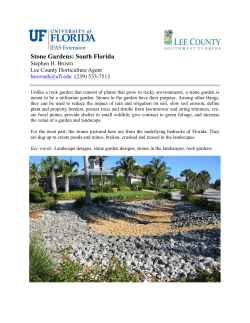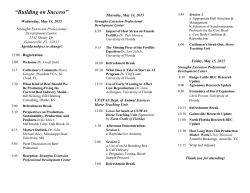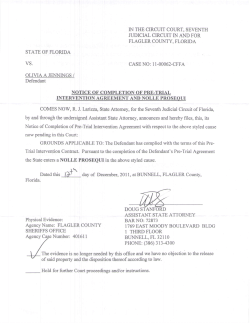
pH News - Orange County Extension Education Center
pH News passion for Horticulture Master Gardener Newsletter Dates to Remember in May May 5, 23 Butterflies, Pollinators, & Beneficials 9A-10:30A, Tuesday, OC 10A-11:30A, Saturday, JB May 5, 12, 19, 26 Central Florida Fairgrounds Demo Garden 7:30A-8:30A. Tuesdays May 9, 21 Minor Vegetables-Extending the Season 9A-10:30A Saturday, OC 6P-7:30P, Thursday, JB May 13 Master Gardener Lunch n Learn Peppers – Some Like it Hot 12N-1:30P, Wednesday, OCEEC May 16, Adopt-A-Tree 8A-12N, South Econ Park 3850 S. Econ Trail, Orlando May 20, MG Advanced Training Tropical Fruit in the Landscape 10A-12N, Wednesday, OCEEC May 21, 22, 23 Creating Hypertufa Planters 6P-8P, Thursday, OC 10A-12N, Friday, OC 9A-11A, Saturday, OC May 26, Mini-gardening: Growing Vegetables in Containers, 6:30P-8P, Tuesday, OCEEC May 28, 29, Trees 101 6:30P-8P, Thursday, JB 10A-12N, Friday, OC Gardening Tips? Plant Swaps? Gardening Give-a-ways? Plant Shows? Plant Sales? Send articles to Carol Jespersen marjesp@gmail.com May, 2015 Inside this Issue: Page 2: From My Side of the Fence Page 3: What to Expect in May Page 5: New Publications Page 8: Exploration Gardens Page 9: Frogfruit Page10: Q & A Page12: Sunday in the Garden Page13: Roots of knowledge Page14: Vegetable Gardening Page15: MG Specials Extension Agent III Environmental Horticulture Orange County Extension http://orange.ifas.ufl.edu/mg The Institute of Food and Agricultural Services is an Equal Employment Opportunity-Affirmative Action Employer authorized to provide research, educational information and other services only to individuals and institutions that function without regard to race, color, sex, age, handicap or national origin. Orange County Extension Service is a Division of the University of Florida, a department of the Orange County Health and Family Services Division. From My Side of the Fence By Ed Thralls, Orange County Master Gardener Coordinator: “Don't grumble that roses have thorns...be thankful that thorns have roses!...Anon April showers bring May flowers, no, Lovebugs. Are you ready to answer homeowner calls regarding this nuisance insect? The monthly Lunch ‘N’ Learn will be on Wednesday, May 13th, at noon in the Azalea Room. The topic will be “Peppers – Some Like it Hot” and will be presented by me. Hot dogs and a few snacks will be available. Guests are welcome. Welcome Jenna Allen, our new Administrative Assistant. I hope to have her attend the Lunch ‘N’ Learn but if she can’t, then by all means, stop by and introduce yourself to her. I want to thank you all for the great job you have been doing for UF/IFAS Extension Service Orange County. We have been responding in an unusually high number of requests from public entities. You all have excelled at representing all that is good with the Master Gardener Volunteer Program. I have received numerous phone calls boasting about the professionalism you exhibit. This is not only a great reflection on you as a professional but also does me some good too. Thank you. Congratulations to Master Gardner Janice Oberwetter for coordinating the successful “Introduction to the Master Gardener Volunteer Program” with over 50 interested residents in attendance. Upcoming events include a summer team builder in June (Sunday in the Garden), New MG Volunteer Training starting in early September, a fall team builder in early October (Plant Festival), the Annual Florida MG Conference in late October. “Flowers are beautiful hieroglyphics of nature, with which she indicates how much she loves us.” Wolfgang von Geothe Ed Thralls, Orange County Master Gardener Coordinator. *********************************************************************************************** 2 What to Expect in May By Ed Thralls May is usually a drought month with about 3.5 inches of rain typical for Central Florida. Night time temperature will continue to climb into the 70’s once in awhile. Expect fungal diseases to increase, especially for those who over water. Lovebugs show up in May. Lovebugs are not pests released by the University of Florida. They migrated from Central America, through Texas and Louisiana during the 1920’s and arrived in Florida in 1947. Applying a spray non-stick vegetable spray to the surface of your car will provide no protection. Learn more about Lovebugs from EDIS publications: MG-068 Lovebugs in Florida and IN-694 Living with Lovebugs. It is too late to plant summer vegetables with the exception of Okra, Sweet Potatoes and Black-Eyed Peas. Late blight may begin appearing on tomatoes as well as blossom end rot. Usually moisture extremes/poor irrigation practices are the cause of most blossom end rot. Once it appears, there is little else that can be done except to prepare for next year by placing gypsum in the soil and provide a consistent moisture once fruit appears. Squash needs a pollinator to move pollen from the female flower to the male flower. Remember that the female flower has a small rudimentary vegetable formed at the base of the flower. Both flowers and a pollinator must be present for pollination to occur. You can be the pollinator if not enough bees are around. See EDIS publication: Home Vegetable Garden Techniques: Hand Pollination of Squash and Corn in Small Gardens (http://edis.ifas.ufl.edu/pdffiles/HS/HS39800.pdf) Hurricane season is about a month away. This would be a good time to get outside and look up into the trees for damage that was not spotted at the beginning of spring. If the tree health is suspicious or if there are large (greater than 4” in diameter) limbs that are cracked or broken, consider consulting with a Certified Arborist. This is the last “good” month to place sod in shady areas until fall. Chinch bugs and mole crickets may appear in greater numbers now. So be prepared to apply a synthetic Pyrethroid for control. If the Pyrethroid does not give control in 3-4 weeks, apply an insecticide with Dylox (trichlorfon) to reduce the potential for resistance to develop. It is may be too hot for fertilizer at this time of year so consider an application of iron to green up the turf. If we get a few cooler days and you didn’t fertilized your turfgrass this Spring, then now is the last time until October so don’t pass it up. Remember the Fertilizer Blackout Ordnance in Orange County goes into effect June 1st. The dry times ahead are ideal for large spider mite populations. Horticulture oils (Vegol, Organocide, Pure Spray, Neem, or Volck) are good controls but remember that they should not be applied at temperatures over 85°F. Sometimes it is better to remove a small plant and replace it than pay for horticultural oil and try to control the pest that has severely damaged the plant. Fruit flies and worms will become more numerous as new fruit; especially as tropical fruit begin more rapid growth this month. The flies cannot usually be controlled but the fruit can be protected by placing it in a paper bag over the fruit to keep the flies away from the fruit. Most citrus has 3 bloomed and now the plants are “self-trimming” themselves. Expect calls regarding fruit and leaf falling from trees. Increase moisture to the plant and make sure that fertilizer is being applied at the four-time-a-year schedule. Suspect Citrus Greening so ask for samples to be brought to the Clinic for inspection. Sago scale is still a pest of some notoriety. Horticultural oils are recommended for control on a three week cycle of application once a week, then on the fourth week, wash away dead scale with a heavy spray of water (they don’t drop off when they die). Be prepared to do this several times a year. Do not remove fronds unless they are yellow or brown. The plant needs the green fronds to make food for itself. Master Gardener Gene Hafich setting up for Fever in the Garden event in Winter Garden (April 11, 2015) 4 New Publications –April, 2015 Not All Landscape Palm Fertilizers Are Created Equal Palms are widely planted in Florida landscapes. Their bold leaf textures create a tropical or Mediterranean look that is highly desired by residents and tourists alike. But palms have very high nutritional requirements, and deficiencies of any element can result in conspicuous and unattractive symptoms on their large leaves. UF/IFAS research shows that the most effective fertilizer has 100% of the N, K, Mg, and B sources in slow-release or controlled-release form and that all of the Mn, Fe, Zn, and Cu sources should be water soluble. http://edis.ifas.ufl.edu/ep516 Butia odorata: Pindo Palm The pindo or jelly palm is a small, single-stemmed, feather-leaved palm widely grown in warmer parts of the US due to its unusual cold tolerance. It is considered hardy down to about 10oF (USDA zone 8A). The palm is slow-growing, eventually reaching 15 to 20 feet, making it suitable for planting under power lines. http://edis.ifas.ufl.edu/st105 Pepper Production in Miami-Dade County, Florida Pepper is an important vegetable crop in Miami-Dade County. Unlike other vegetable crops, peppers are relatively more adaptable to the environment, especially the heat, and are relatively easier to grow. But to be successful, careful attention must be paid to maintain healthy plants and high productivity with efficient management of soil and water for the particular needs of each variety or cultivar. This 7-page fact sheet provides general information and guidelines for pepper growers in Miami-Dade County, including major pepper varieties, and their horticultural traits, and fundamental soil and water management requirements. http://edis.ifas.ufl.edu/tr010 Tree Assistance Program for Florida Citrus Greening In September 2014, the USDA Farm Service Agency (FSA) announced additional support for commercial Florida citrus growers to manage greening, in the form of an expansion of the Tree Assistance Program (TAP). The original program assisted growers in the event the loss occurred within a single year due to a natural disaster such as a hurricane. The expanded TAP recognizes citrus greening (Huanglongbing, or HLB). The program provides growers cost-sharing financial assistance to replace trees that meet a mortality criterion within a time period of up to six years. http://edis.ifas.ufl.edu/fe966 Contaminants in the Urban Environment: Perfluoroalkyl Substances Perfluoroalkyl substances (PFASs) or perfluorochemicals (PFCs) are the most widespread and persistent manmade chemicals on earth. Common products that contain PFASs are Teflon pans, non-stick cookware, rain/waterproof jackets (like Gore-Tex), fire-fighting foams, food packaging, carpets, and furniture fabrics. PFASs stay in the environment for a long period of time, which means they can accumulate in organisms to levels that cause harmful effects. http://edis.ifas.ufl.edu/ss631 5 Contaminants in the Urban Environment: Pharmaceuticals and Personal Care Products (PPCPs) Pharmaceuticals and personal care products contain a variety of chemical substances that enter household wastewater from bath and shower, sinks, and washers and ultimately find their way into the environment. Continuous discharge of wastewater contributes to the accumulation of these substances in the environment — where they can be harmful to organisms. Part 1 provides an overview of the use and sale of PPCPs in the United States and the world: http://edis.ifas.ufl.edu/ss632 Part 2 discusses the sources and impacts of PPCPs and offers common-sense ways we can protect our environment from PPCPs. http://edis.ifas.ufl.edu/ss633 Floridian Consumer Perceptions of Local versus Organic Ornamental Plants Horticultural consumers in Florida are interested in local and organically produced plants. But these terms can mean different things in different regions. UF/IFAS researchers conducted a survey last summer which suggests that consumers in central Florida define local as plants that are grown near where they are sold and identify the most important local benefits as product safety, quality, and community support. Organic plants are perceived as requiring fewer chemical additives and being healthier for the environment. The importance of these traits varies by plant type. http://edis.ifas.ufl.edu/fe964 Selecting Cultivars of Lettuce for Production Using Hydroponics and Protected Culture in Florida With correct variety selection and protected culture strategies, lettuce is a crop that can present even the novice grower with a fast-growing commodity for market sale. This includes brief descriptions of hydroponic lettuce production systems, cultivars, and a table summarizing the lettuce types successfully grown in Florida using protected agriculture and hydroponic techniques. http://edis.ifas.ufl.edu/hs1258 Yellowmargined Leaf Beetle: A Pest of Cole Crops The yellowmargined leaf beetle is a pest of cole or cruciferous crops that is native to South America. Since first reported in Mobile, Alabama, in 1947, the beetle has spread throughout the Gulf Coast from Texas to Florida and up into Georgia and North Carolina. It has also been reported from Illinois and California. Not considered a major pest in conventionally grown cruciferous crops because it is susceptible to a wide range of insecticides, it poses a significant threat to the growing organic industry in the southeastern United States. It is a particular problem on Asian greens such as mizuna, mibuna, and napa cabbage, as well as on other high-value cruciferous crops like turnip, mustard, and watercress. http://edis.ifas.ufl.edu/in1049 Lepidoptera: Io Moth The beautiful Io moth is one of our most recognizable moths, because of its prominent hind wing eyespots. The attractive Io moth caterpillar is also well-known because of its painful sting. But like many of the other saturniid moths, is less common now in parts of its range. With the exception of Cape Cod and some of the Massachusetts islands, it is now rare in New England where it was once common, and its populations have declined in most of the Gulf States since the 1970s. http://edis.ifas.ufl.edu/in1065 6 Squash Vine Borer Squash vine borer is a moth species that is active during the day (diurnal). The larvae complete their growth and development on wild and domesticated species of the genus Cucurbita. Once only considered a nuisance to commercial growers, with the expansion of cucurbit production in the United States over the last decade, the squash vine borer has become a pest of economic importance. http://edis.ifas.ufl.edu/in1068 Tawny Crazy Ant (previously known as Caribbean crazy ant) Nylanderia fulva is part of a group of ants referred to as “crazy ants” due to their quick and erratic movements. It has been reported from 27 counties of Florida and 27 counties of Texas, as well as from Louisiana, Mississippi, Alabama and Georgia. Huge number of workers in infested areas can make human activities uncomfortable and difficult. They can infest sidewalks, buildings and gardens, and damage phone lines, air conditioning units and computers. They have killed honey bee larvae and used the hives as their nests, and are even displacing red imported fire ants where the two populations overlap in Texas. http://edis.ifas.ufl.edu/in1071 Managing Conflicts with Wildlife: Living with Snakes Snakes provide numerous benefits to people and to the environment, by controlling rat and mice populations in the environment, for example. or in the laboratory, where pygmy rattlesnake venom research helped develop medicine to thin the blood of heart attack patients. Most snakes are secretive and rarely bother people, but there are situations where some snakes can become dangerous. In this 4-page fact sheet, we present some facts about snakes, describe dangers they may cause, and provide suggestions on how to cope with these dangers. http://edis.ifas.ufl.edu/uw395 Master Gardeners Janice Oberwetter and Gene Hafich at the 54th Art and Foliage Festival in Apopka (April 26, 2015) 7 Katie Abercrombie You may have noticed some excitement in the Exploration Gardens over the last month or so. The Eco-Garden has been converted into our new Trial Garden! For the third year, UF-IFAS extension has teamed up with the Florida Nursery, Growers, and Landscape Association, Harry P. Leu Gardens, and the Disney Horticulture team to study and showcase the newest and best varieties of flowering plants for Florida’s unique growing conditions. These plants have been on display at Epcot during the International Flower and Garden Festival, of course, but now you can see many of them right here in our own Exploration Garden! Our new garden will be featured in FNGLA’s 2015 Floriculture Field Days & Performance Trials on Thursday, May 14. If you want more information or to register for the event, visit www.fngla.org. Or, you could just drop by the gardens to check out all the beautiful blooms and color! According to Extension Agent Kelly Greer, the former Trial Garden at the tip of the oval is featuring the top three varieties from last year’s trials as well as some ground cover and perennial plant demonstrations. The rest of the Trial Garden is loaded with opportunities to see how different varieties fare in Central Florida’s climate. Drop by and get some ideas for your Central Florida flower garden! 8 Frogfruit By Dena Wild On behalf of the Florida Wildflower Association Remember the saying, “You can’t judge a book by its cover”? The same holds true for Frogfruit. It is neither a frog nor a fruit. It does not look like a frog, or a fruit. What it is and looks like is a flowering native ground cover. Frogfruit, Phyla nodiflora. This plant is also known as turkey tangle fogfruit, cape weed, match weed and match-head. Regardless of what you call it, this short lived perennial ground cover grows to about 2-1/2 inches high and has very showy white and purple flowers. It is the host plant for white peacock (Anartia jatrophae), phaon crescent (Phyciodes phaon), and common buckeye (Junonia coenia) butterflies. It is also a good nectar source for hairstreaks. Family: Verbena (Verbenaceae) Hardiness: North, Central and South Florida (Zones 8–11). Soil: Sandy, clay and loam. Exposure: Full sun to partial shade. Growth habit: Opposite leaves, flower on long stalks which looks like a match head. Short leaf stalk, hairs on top and bottom of blade and stem, serrated leaf margins. Frogfruit reappears once the temperature warms up in the spring months. The plant can be propagated through divisions. It will grow almost everywhere, dry-moist-wet sites. Garden tips: Frogfruit works great in a hanging basket. Because of its high salt tolerance, it is a good plant for Florida’s coastal areas. 9 Questions & Answers Q: It is now going on my 3rd year with Zoysia. It seems like I am seeing more and more Bermuda taking over and coming up in the Zoysia. Is that the normal course of this stuff? Is there a way to spray out the Bermuda and leave the Zoysia? A: I found this information on the web from a study done at the University of Georgia. “The postemergence herbicide Fusilade II (click for sources) (active ingredient fluazifop, fluazifop-P-butyl) is labeled by Zeneca (Syngenta) for control of bermudagrass in zoysia. The label says “Applications should be made around June 1 and repeated about every 28 to 30 days.” The label does not say how many applications are needed, or whether it is possible to eradicate Bermuda in zoysia. Rates can vary from 2 to 5 fluid ounces per acre, depending on the situation. The label contains other cautions and should be read prior to application, and followed. In research by the University of Georgia’s Dr. B. J. Johnson, two successive years of treatment (two applications per year, both at higher than the labeled rate) resulted in reduction of bermudagrass from 35% down to 7%, and increase of zoysia cover from 65% to 85%. The selective removing of one perennial grass from another perennial grass is often a tedious project requiring diligence.” Q: For the past three years, fleas have begun congregating around my deck area in the back yard. They are in no other location. I have no outdoor pets. I only have a cat that lives on my screened porch 24/7 which is a short distance away from the deck. Any idea why fleas will come to the exact same place year after year? An exterminator is working with me, but so far an initial application of whatever he used is not working and the fleas have never been worse. He comes back Monday to retreat. Secondly, can you tell me a little about growing peaches in central FL? I’ve recently put two in my side yard. I know just enough to likely get me in trouble, and at the very least, they are a pretty tree, even if they don’t fruit, but I’d appreciate suggestions you have on how to successfully grow them A: Fleas usually come back to the same spot because the animal carrying them comes back to that same spot. I suspect squirrels as your source of fleas. Your applicator should be able to control the adult fleas but he will need to retreat because the insecticide does not usually affect any eggs that have been laid by the fleas. See the two attachments regarding fleas. (ENY-205, ENY-291) If you have the correct variety of peach tree, one that will grow in Florida where we do not experience enough chilling hours each year for the Georgia peach trees to survive. I have also provided several publications for growing peaches. Water them at least 1” of water per week. And when you apply fertilizer, drop the granular fertilizer at the canopy drip line and then extend out three feet. There is no use to apply fertilizer under the tree canopy. Insecticides and 10 fungicides are necessary and are used more often than you would think to get a quality crop. (Cir 1159, HS1111, ENY-804, ENY-691 Q: I have attached some pictures I recently took of a sick Queen Palm we have in our yard in east Orlando. It is one of 4 and is the only one with a problem. It's been going downhill for maybe 2 years. I first noticed that the fronds that were open would become ragged closest to the trunk. I thought maybe a night owl or hawk was landing on them and making them that way. But it worsened. Then the new fronds shoots would not open up completely. It hasn't put out a new shoot in over 6 months while the other 3 continue to grow normal. A: I suspect your palm was planted too deeply and is not able to adequately process the fertilizers and water you have been giving it over the past couple of year. The roots may be starving for oxygen. There may also be some insect damage at the top of the tree. The brown residue in one picture doesn’t look good. You really need to get a Certified Arborist (http://treesaregood.org) onsite to look at it’s overall health before deciding to remove it or work on it to improve its health. Q: I've got one lower area of my property that has a lot of elephant ear type plants and I mow them over and a week later they're coming up again and I'm trying to knock them down so I can grow grass back there, not elephant ears. Not doing so well, any suggestions? A: “Elephant Ear” plants, may also be Taro, are difficult to control once they get started. The Center for Aquatic and Invasive Plants at UF recommend several methods: 1. The first step in preventative control of elephant ear and taro is to limit planting and removal of existing plants within the landscape. 2. Dig out corms from the soil. Take care when cutting, as the leaves contain oxalic acid, which may cause irritation to exposed skin. 3. Chemicals with known control are limited. Repeated applications of glyphosate (2% solution), aka Round Up, with a surfactant may be effective, especially if coupled with other management strategies. 11 Florida Friendly Garden Downtown Orlando on Earth Day, April 22, 2015 Photos by Phyllis Stopford Extension Agent Kelly Greer, Master Gardeners Mark Bennett, Pat Summers, Betsy Garrison, Phyllis Stopford and Jon Rodeheffer This is one of several Exploration Gardens in Orange County and is located at the County Administration Building +++++++++++++++++++++++++++++++++++++++++++++++++++++++++++++++++++++++++++++++++++++++ Sunday in the Garden Sunday May 31st 3:00pm – 6:00pm Hostess: Master Gardener Peggy Green 1900 Brumley Road, Chuluota, FL 32766 RSVP: peggymgreen@bellsouth.net (call 407-405-1284 for directions) 12 Carolyn Bird FLORIDA’S FABULOUS INSECTS, by Mark Deyrup, 2000. II 51 Ed’s MG Advanced Training was on Insects and so you may find this book delightful. Or is that stretching it?!?! We know Ed would enjoy the up close and personal, spectacular photographs and write ups. And we will too! This is an odd book - the usual beginning pages are all in the back: cover page, opening statement, table of contents, etc.! The book begins immediately with a large picture of an insect saluting and a poem: “Salute to a Bug” – Bug, insect, oh giant beast, If you were taller, And I were smaller, I’d run from you at a hundred miles an hour at least. The next picture is of a grasshopper and I found myself studying the nasty critter. Then I saw a 4” silverfish beautifully portrayed and knew this book was tolerable even for skittish me! I found articles about identifying Florida’s ants by their mounds, social behavior in insects, firefly species, and an amusing bit about Aristotle and the gender of honey bees. The Meaning of Green is not referencing Kermit but iridescent colors. What a treat these pictures are as is the information. Enjoy. I will. 13 Central Florida Fairgrounds Vegetable Gardens In the Vegetable Garden...............submitted by Alicia Yeatman . We have been taking out most of the cool weather vegetables and planting those suitable for this time of the year. We still have kale, collards, Swiss chard, celery and fennel that haven't been taken out yet. The fennel attracts swallowtail butterflies and will be left in the garden for that purpose. We are seeing caterpillars each week. Silver Queen sweet corn was planted the first of the month and Bt applied after seeing worm damage. With the rain washing away the Bt and only working the garden one day a week it is going to be a chore to get a crop. A lot of damage can occur between garden visits. We are still harvesting carrots and the first of the celery. Blue Lake pole beans, okra, and Zipper Cream peas are all green and growing. A Loquat tree was planted in the area where the citrus trees were taken out. The flower areas are full of blooms and attracting lots of pollinators. If you would like to volunteer in the garden we are there each Tuesday morning by 7:30 am. We have wonderful volunteers that continue to give their time. I find that each Master Gardener brings new ideas, methods of growing and insect control. Our diverse gardening backgrounds make it an interesting and fun experience in the garden each week. Master Gardeners volunteering in the garden this month were: Phyllis Stopford, Susan Ledbetter, Sue Napolitano, Jon Rodeheffer, and Sandy Holdeman. Thank you Phyllis for the photos. Tuesdays from 7:30 am to 8:30 am 14 Master Gardener Specials May Birthdays: 2 3rd 4th 5th 5th 5th 16th 18th 26th 26th 28th nd Joseph Hegedus Tania Harmon Jamie Gaines Nancy Bauer Pam Elliot Nancy Megill Pam Paisley Dawn Renda Sandy Holdeman Don Hill Solomon Spencer May Anniversaries: 5th 5th 13th 25th 26th 30th Amy Baggett Karen Schafer Susan Block Betsy Garrison Tsehaye Samson Connie Deere Contributors: Paulette Smith Ed Thralls Dena Wild Alicia Yeatman Carol Jespersen Clinic Raffle Drawing: Jamie Gaines is the lucky winner of a book Future Articles: Send articles to Carol at marjesp@gmail.com And cc: Ed at: ed.thralls@ocfl.net Happy Gardening! pH News The information presented in pH News comes from a variety of sources, including not only official University of Florida and Orange County Government, but also unofficial sources and individuals. Every effort is made to present current and accurate information. The Master Gardener Coordinator edits all of the pages presented here for grammar, spelling, and corrects or deletes information in an article that is not appropriate for a Master Gardener Newsletter. Each author of an article must abide by University policies and local, state, and federal laws. April Statistics: Volunteer Hours……………….739 Value…………………..….$17,898 Soil Tests…………………………6 Plant ID…..……………………..27 Insect ID………………….…….98 Disease Problems…………….....00 Plant Problems…………… ……39 Other………….…………….…..00 OCMG Blog: http://ocmg.blogspot.com OCMG Twitter: http://twitter.com/ocmgs OCMG Facebook: http://www.facebook.com/ocmgs OCMG Webpage: http://orange.ifas.ufl.edu/mg 15
© Copyright 2025









